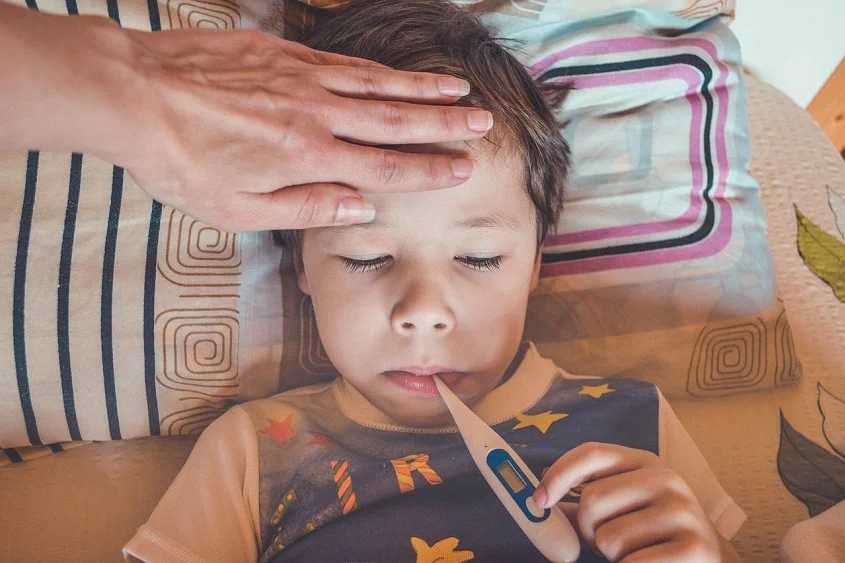Common Childhood Illnesses: Prevention, Symptoms, and When to Seek Medical Attention
- Updated on: Dec 27, 2023
- 3 min Read
- Published on Dec 27, 2023

As parents, caregivers, or anyone involved in the well-being of children, facing childhood illnesses can be a daunting task. Kids are notorious for their boundless energy, but they’re also susceptible to a range of common illnesses that can leave them and their caretakers feeling a bit overwhelmed. Below, we discuss how to prevent these illnesses, recognize their symptoms, and, most importantly, understand when it’s time to seek professional medical attention.
6 Common Childhood Illnesses
1. Fever
A fever is like a flare in the night sky, signaling that the body is in battle mode. It’s a common response to infections, and while a mild fever is often manageable at home, persistent or high fevers may require a visit to the healthcare provider.

2. Common Cold
The common cold is a frequent visitor to kids. If your child starts showcasing an impressive array of sniffles, sneezes, and a runny nose, they’ve likely caught a cold. Rest, fluids, and perhaps some chicken soup usually do the trick.
3. Ear Infections
If your little one is tugging at their ear or seems unusually irritable, an ear infection might be lurking. An ear infection may often lead to mastoiditis, which can get pretty severe. If the pain persists or is accompanied by a fever, it’s time for a healthcare consultation.
4. Chickenpox
Symptoms often include itchy rash, fever, and flu-like symptoms. If there are signs of infection or if the child appears very ill, please seek urgent medical attention. However, vaccination is the best preventive measure.
5. Tummy Troubles
Stomach bugs can turn a cheerful day into a challenging one. Vomiting and diarrhea may be signs of a viral infection or foodborne illness. Keep an eye on hydration levels, and consult a healthcare professional if symptoms persist.
6. Measles
Symptoms often include high fever, cough, runny nose, and a characteristic red rash. Vaccination is highly effective in preventing measles and is usually the best thing to do. Seek medical attention if the child develops a high fever, experiences difficulty breathing, or if the rash spreads rapidly.
How to Prevent Common Childhood Illnesses
While it’s impossible to shield your kids from every germ, a few practical steps can significantly reduce the risk of falling prey to common ailments.
Immunizations
Regular vaccinations are a powerful defense against diseases like measles, mumps, and rubella. Keep a close eye on the immunization schedule recommended by healthcare professionals and ensure your child is up to date.
Regular Handwashing
It may sound simple, but the power of handwashing is truly magical. Teach your kids the art of scrubbing their hands with soap and water, especially after playing outdoors, using the bathroom, or before meals. It’s a simple yet effective way to fend off many common infections.
Balanced Nutrition
Fueling your child’s body with a balanced diet is like providing it with a superhero suit. A diet rich in fruits, vegetables, whole grains, and lean proteins boosts the immune system, making it more resilient against infections. Limit the sugary snacks, and you’ll be steering clear of a villainous path.
Adequate Sleep
Sleep is the unsung hero of good health. Ensure your child gets the recommended amount of sleep for their age. A well-rested body is better equipped to fight off infections, and it sets the stage for a more energetic and resilient playtime the next day.
When to Seek Urgent Medical Attention
While you can handle some illnesses yourself, knowing when to call in the doctor is perhaps the most critical aspect of managing childhood illnesses. Below are some situations that may demand the attention of healthcare providers:
Breathing Issues
If your child is having difficulty breathing or is showing signs of respiratory distress, it’s time to hit the panic button—well, not literally, but seeking immediate medical attention is crucial. Respiratory issues can escalate rapidly, especially in younger children.
High Fever and Lethargy
A persistently high fever accompanied by lethargy or an unwillingness to engage in normal activities is a red flag. This may indicate a more serious infection that requires medical evaluation.
Dehydration
Kids can be little Houdinis when it comes to hiding signs of dehydration. Keep an eye out for reduced urine output, dry mouth, or lethargy, and seek medical attention promptly if you suspect dehydration.
Unexplained Rashes
While rashes are often harmless and can be attributed to various factors, an unexplained or rapidly spreading rash should not be taken lightly. It could be a sign of an allergic reaction or a more serious condition requiring medical assessment.
Wrapping Up
When it comes to childhood illnesses, a blend of prevention, early symptom recognition, and timely medical attention is your best bet. Embrace the journey with resilience and a well-stocked first aid kit. After all, each bout with illness is a chapter in the epic tale of growing up—one that shapes both the little ones and the superheroes who care for them. So, equip yourself with knowledge and maybe a superhero cape, and face the adventure head-on.












